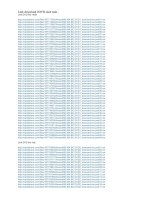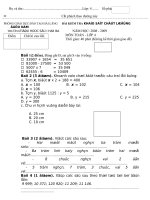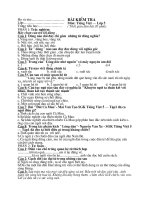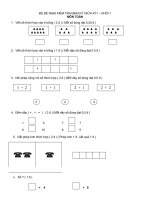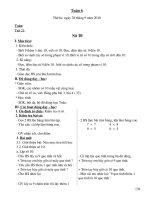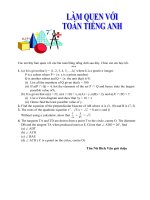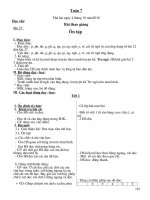Sach toan Tieng Anhhay 2G2010
Bạn đang xem bản rút gọn của tài liệu. Xem và tải ngay bản đầy đủ của tài liệu tại đây (120.94 KB, 6 trang )
<span class='text_page_counter'>(1)</span><div class='page_container' data-page=1>
Math 528 Jan 11, 20051
Geometry and Topology II
Fall 2005, USC
<b>Lecture Notes 2</b>
<b>1.4</b> <b>Definition of Manifolds</b>
By a <i>basis</i> for a topological space (<i>X, T</i>), we mean a subset <i>B</i> of <i>T</i> such that for
any <i>U</i> <i>∈T</i> and any <i>x∈U</i> there exists a<i>V</i> <i>∈B</i> such that <i>x∈V</i> and<i>V</i> <i>⊂U</i>.
<b>Exercise 1.4.1.</b> Let<b>Q</b> denote the set of rational numbers. Show that
<i>{B</i><sub>1</sub><i>n<sub>/m</sub></i>(<i>x</i>)<i>|x∈</i><b>Q</b><i>n</i> and <i>m</i>= 1<i>,</i>2<i>,</i>3<i>, . . .}</i>
forms a basis for <b>R</b><i>n</i>. In particular, <b>R</b><i>n</i> has a countable basis. So does any subset
of <b>R</b><i>n</i> with the subspace topology.
<b>Exercise 1.4.2.</b> Let<i>T</i> be the topology on <b>R</b> generated as follows. We say that a
subset <i>U</i> of <b>R</b> is open if for every <i>x</i> <i>∈U</i>, there exist <i>a</i>, <i>b∈</i><b>R</b> such that <i>x</i> <i>∈</i>[<i>a, b</i>)
and [<i>a, b</i>) <i>⊂</i> <i>U</i>. Show that <i>T</i> does not have a countable basis. (<i>Hint:</i> Let <i>B</i> be a
basis for <i>T</i>, and for each<i>x</i> <i>∈</i><b>R</b>, let <i>Bx</i> be the basis element such that <i>x∈Bx</i> and
<i>Bx</i> <i>⊂</i>[<i>x, x</i>+ 1).)
A toplogical space <i>X</i> is said to be <i>Hausdorf</i>, if for every pair of distinct points
<i>p1</i>, <i>p2</i> <i>∈</i> <i>X</i>, there is a pair of disjoint open subsets <i>U1</i>, <i>U2</i> such that <i>p1</i> <i>∈</i> <i>U1</i> and
<i>p2</i> <i>∈U2</i>.
<b>Exercise 1.4.3.</b> Show that any compact subset of a Hausdorf space<i>X</i> is closed in
<i>X</i>.
<b>Exercise 1.4.4.</b> Let<i>X</i>be compact,<i>Y</i> be Hausdorf, and<i>f</i>:<i>X→Y</i> be a continuous
one-to-one map. Then<i>f</i> is a homeomorphism between<i>X</i> and <i>f</i>(<i>X</i>).
We say that <i>X</i> <i>⊂</i><b>R</b><i>n</i> is<i>convex</i> if for every<i>x</i>,<i>y</i> <i>∈X</i>, the line segment
<i>λx</i>+ (1<i>−λ</i>)<i>y,</i> <i>λ∈</i>[0<i>,</i>1]
lies in<i>X</i>
<b>Exercise 1.4.5 (Topology of Convex Sets).</b> Show that every compact convex
subset of <b>R</b><i>n</i>, which contains an open subset of <b>R</b><i>n</i>, is homeomorphic to <i>Bn</i>1(<i>o</i>).
(<i>Hint:</i> Suppose that <i>o</i>lies in the open set which lies in<i>X</i>. Define<i>f</i>:<b>S</b><i>n−</i>1<i>→</i><b>R</b> by
<i>f</i>(<i>u</i>) := sup<i>x∈Xu, x</i>. Show that <i>g</i>:<i>X</i> <i>→</i> <i>Bn</i>1(<i>o</i>), given by <i>g</i>(<i>x</i>) :=<i>x/f</i>(<i>x/x</i>), if
<i>x</i>=<i>o</i>, and <i>g</i>(<i>o</i>) :=<i>o</i>, is a homeomorphism.)
</div>
<span class='text_page_counter'>(2)</span><div class='page_container' data-page=2>
By a<i>neighborhood</i> of a point<i>x</i>of a topological space<i>X</i> we mean an open subset
of <i>X</i> which contains<i>x</i>. We say a topological space<i>X</i> is<i>locally homeomorphic</i> to a
topological space <i>Y</i> if each <i>x</i> <i>∈</i> <i>X</i> has a neighborhood which is homeomorphic to
<i>Y</i>.
By a <i>manifold</i> <i>M</i>, we mean a topological space which satisfies the following
properties:
1. <i>M</i> is hausdorf.
2. <i>M</i> has a countable basis.
3. <i>M</i> is locally homeomorphic to<b>R</b><i>n</i>.
The “<i>n</i>” in item 3 in the above defintion is called the<i>dimension</i> of <i>M</i>.
<b>Exercise 1.4.6.</b> Show that condition 3 in the definition of manifold may be replaced
by the following (weaker) condition:
3’. For every point <i>p</i> of <i>M</i> there exist an open set <i>U</i> <i>⊂</i> <b>R</b><i>n</i> and a one-to-one
continuous mapping<i>f</i>:<i>U</i> <i>→M</i>, such that<i>p∈f</i>(<i>U</i>).
Conditions 1 and 2 are not redondant, as demonstrated in the following Exercise:
<b>Exercise 1.4.7.</b> Let<i>X</i> be the union of the lines <i>y</i> = 1 and <i>y</i> =<i>−</i>1 in <b>R</b>2, and <i>P</i>
be the partition of<i>X</i> consisting of all the subsets of the form<i>{</i>(<i>x,</i>1)<i>}</i>and<i>{</i>(<i>x,−</i>1)<i>}</i>
where<i>x≥</i>0, and all sets of the form <i>{</i>(<i>x,</i>1)<i>,</i>(<i>x,−</i>1)<i>}</i> where<i>x <</i>0. Show that <i>X</i> is
locally homeomorphic to <b>R</b>but is not hausdorf.
It can also be shown that there exist manifolds which satisfy conditions 1 and 3
but not 2. One such example is the “long line”, see Spivak.
Finally, it turns out that we do not need to wory about condition 2 if our
topological space is compact
<b>Theorem 1.4.8.</b> <i>If a topological space is compact, and satisfies conditions</i>1 <i>and</i>3<i>,</i>
<i>then it satisfies condition</i> 2 <i>as well. In particular, it is a manifold.</i>
<b>1.5</b> <b>Examples of Manifolds</b>
<b>Exercise 1.5.1.</b> Show that<b>S</b><i>n</i> is a manifold.
<b>Exercise 1.5.2.</b> Show that any open subset of a manifold is a manifold, with
re-spect to the subspace topology.
<b>Exercise 1.5.3 (Product Manifolds).</b> If <i>M</i> and <i>N</i> are manifolds of dimension
</div>
<span class='text_page_counter'>(3)</span><div class='page_container' data-page=3>
We say that a group <i>G</i> <i>acts</i> on a topological space <i>X</i> if for every <i>g</i> <i>∈</i> <i>G</i> there
exists a homeomorphism <i>fg</i>:<i>X→X</i> such that
1. <i>fe</i> is the indentity function on<i>X</i>.
2. <i>fg◦fh</i>=<i>fg◦h</i>.
where<i>e</i>is the indentity element of <i>G</i>. For each<i>p∈X</i>, the<i>orbit</i> of <i>p</i>is
[<i>p</i>] :=<i>{g</i>(<i>p</i>)<i>|g∈G}.</i>
<b>Exercise 1.5.4.</b> Show that The collection of orbits<i>P</i> :=<i>{</i>[<i>p</i>]<i>|p∈X}</i>is a partition
of <i>X</i>.
When <i>P</i> is endowed with the quotient topology, then the resulting space is
denoted as <i>X/G</i>.
<b>Exercise 1.5.5.</b> For each integer<i>z∈</i><b>Z</b>, let<i>gz</i>:<b>R</b><i>→</i><b>R</b>be defined by<i>gz</i>(<i>x</i>) :=<i>x</i>+<i>z</i>.
Show that <b>Z</b>acts on<b>R</b>, and <b>R/Z</b>is homeomorphic to <b>S</b>1.
<b>Exercise 1.5.6.</b> Define an action of<b>Z</b><i>n</i> <sub>on</sub> <b><sub>R</sub></b><i>n</i><sub>so that</sub><b><sub>R</sub></b><i>n<sub>/Z</sub>n</i><sub>is homeomorphic to</sub>
<i>Tn</i>.
Let <i>π</i>:<i>X</i> <i>→X/G</i>be given by
<i>π</i>(<i>p</i>) := [<i>p</i>]<i>.</i>
We say that a mapping <i>f</i>:<i>X</i> <i>→</i> <i>Y</i> is open if for every open <i>U</i> <i>⊂X</i>, <i>f</i>(<i>U</i>) is open
in<i>Y</i>.
<b>Exercise 1.5.7.</b> Show that<i>π</i>:<i>X→X/G</i>is open.
We say that <i>G</i> acts<i>properly discontinuously</i> on<i>X</i>, if
1. For every<i>p∈X</i> and<i>g∈G− {e}</i>there exists a neighborhood<i>U</i> of<i>p</i>such that
<i>U</i> <i>∩g</i>(<i>U</i>) =<i>∅</i>.
2. For every <i>p</i>,<i>q</i> <i>∈X</i>, such that <i>p</i>=<i></i> <i>hg</i>(<i>q</i>) for any <i>g</i> <i>∈G</i>, there exist
neighbor-hoods<i>U</i> and <i>V</i> respectively, such that <i>U</i> <i>∩g</i>(<i>V</i>) =<i>∅</i> for all <i>g∈G</i>.
<b>Exercise 1.5.8 (Group Actions).</b> Show that if a group <i>G</i> acts properly
discon-tinuosly on a manifold<i>M</i>, then<i>M/G</i>is a manifold. (<i>Hints:</i> Openness of <i>π</i> ensures
that <i>M/G</i> has a countable basis. Condition (i) in the defintion of proper
disconti-nuity ensures that<i>π</i> is locally one-to-one, which together with openness, yields that
<i>M/G</i> is locally homeomorphic to <b>R</b><i>n</i>. Finally, condition (ii) implies that <i>M/G</i> is
hausdorf.)
</div>
<span class='text_page_counter'>(4)</span><div class='page_container' data-page=4>
<b>Exercise 1.5.10 (Hopf Fibration).</b> Note that, if <b>C</b>denotes the complex plane,
then <b>S</b>1 <sub>=</sub> <i><sub>{</sub><sub>z</sub></i> <i><sub>∈</sub></i> <b><sub>C</sub></b> <i><sub>| </sub><sub>z</sub><sub></sub></i> <sub>= 1</sub><i><sub>}</sub></i><sub>. Thus, since</sub> <i><sub></sub><sub>zw</sub><sub></sub></i> <sub>=</sub> <i><sub></sub><sub>z</sub></i> <i><sub>w</sub><sub></sub></i><sub>,</sub> <b><sub>S</sub></b>1 <sub>admits a natural</sub>
group structure. Further, note that <b>S</b>3 =<i>{</i>(<i>z1, z2</i>) <i>| z1</i>2+<i>z2</i>2 = 1<i>}</i>. Thus, for
every <i>w</i> <i>∈</i><b>S</b>1, we may define a mapping<i>fw</i>: <b>S</b>3 <i>→</i> <b>S</b>3 by <i>fw</i>(<i>z1, z2</i>) := (<i>wz1, wz2</i>).
Show that this defines a group action on<b>S</b>3<sub>, and</sub> <b><sub>S</sub></b>3<i><sub>/S</sub></i>1 <sub>is homeomorphic to</sub> <b><sub>S</sub></b>2<sub>.</sub>
<b>Exercise 1.5.11 (Piecewise Linear (PL) manifolds).</b> Suppose that we have a
collection <i>X</i> of triangles, such that (i) each edge of a triangle in <i>X</i> is shared by
exactly one other triangle (ii) whenever two triangles of<i>X</i> intersect, they intersect
at a common vertex or along a common edge, (iii) each subset of<i>X</i> consisting of all
the triangles which share a vertex is finite and remains connected, if that vertex is
deleted. Show that<i>X</i> is a 2-dimensional manifold.
The converse of the problem in the above exercise is also true: every two
dimen-sional manifold can be “triangulated”.
<b>Exercise 1.5.12.</b> Generalize the previous exercise to 3-dimensional manifolds.
<b>1.6</b> <b>Classification of Manifolds</b>
The following theorem is not so hard to prove, though it is a bit tediuos, specially
in the noncompact case:
<b>Theorem 1.6.1.</b> <i>Every connected</i> 1<i>-dimensional manifold is homeomorphic to </i>
<i>ei-ther</i> <b>S</b>1<i>, if it is compact, and to</i> <b>R</b> <i>otherwise.</i>
To describe the classification of 2-manifolds, we need to introduce the notion of
<i>connected sums</i>. Let<i>M1</i> and <i>M2</i> be a pair of <i>n</i>-dimensional manifolds and <i>X1</i> and
<i>X2</i> be subsets of<i>M1</i> and<i>M2</i> respectively, which are homeomorphic to the unit ball
<i>Bn</i>
1(<i>o</i>). Let<i>Y1</i>and<i>Y2</i> be subsets of<i>X1</i> and<i>X2</i> which are homeomorphic to the open
ball <i>U</i>1<i>n</i>(<i>o</i>), and set
<i>X</i>:= (<i>M1−Y1</i>)<i>∪</i>(<i>M2−Y2</i>)<i>.</i>
Let <i>∂X1</i> := <i>X1−Y1</i> and <i>∂X2</i> := <i>X2−Y2</i>. The each of <i>∂X1</i> and <i>∂X2</i> are
homeo-morphic to <b>S</b><i>n</i>. In particular, there exist a homeomorphism<i>f</i>:<i>∂X1</i> <i>→∂X2</i>. Let<i>P</i>
be the partition of <i>X</i> consiting of all single sets of points in<i>X−</i>(<i>∂X1∪∂X2</i>) and
all sets of the form <i>{p, f</i>(<i>p</i>)<i>}</i>. The resulting quotient space is called the <i>connected</i>
<i>sum</i> of<i>M1</i> and<i>M2</i>.
<b>Theorem 1.6.2.</b> <i>Every compact connected</i> 2 <i>dimensional manifold is </i>
<i>homeomor-phic to exactly one of the following:</i> <b>S</b>2<i>,</i> <b>RP</b>2<i>,</i> <i>T</i>2<i>, the connected sum of finitely</i>
<i>many</i> <i>T</i>2<i>s, or the connected sum of finitely many</i> <b>RP</b>2<i>s.</i>
<b>Exercise 1.6.3 (The Klein Bottle).</b> Show that the connected sum of two<b>RP</b>2s
is homeomorphic to the quotient space obtained from the following partition <i>P</i> of
[0<i>,</i>1]<i>×</i>[0<i>,</i>1]: <i>P</i> consists of all the single sets <i>{</i>(<i>x, y</i>)<i>}</i> where (<i>x, y</i>) <i>∈</i>(0<i>,</i>1)<i>×</i>(0<i>,</i>1),
all sets of the form <i>{</i>(x,0),(x,1)<i>}</i> where <i>x</i> <i>∈</i> (0<i>,</i>1), and all the sets of the form
</div>
<span class='text_page_counter'>(5)</span><div class='page_container' data-page=5>
Once the dimension reaches 3, however, comparitively very little is known about
classification of manifolds, and in dimensions 5 and higher it can be shown that it
would not be possible to devise any sort of algorithm for such classifications. Thus
it is in dimensions 3 and 4 where the topology of manifolds is of the most interest.
The outstanding question in 3-manifold topology, and perhaps in all of
Mathe-matics (the only other problem which one might claim to have priority is Riemann’s
hypothesis) is the <i>Poincare’s conjecture</i>, which we now describe.
We say that a manifold <i>M</i> is<i>simply connected</i> if for every continuous mapping
<i>f</i>:<b>S</b>1 <i>→</i> <i>M</i> there is a continuous mapping <i>g</i>:<i>B</i>12(<i>o</i>) <i>→M</i>, such that <i>g</i>=<i>f</i> on <b>S</b>1.
For instance, it is intuitively clear that<b>S</b>2 is simply connected, but <i>T</i>2 is not.
<b>Problem 1.6.4 (Poincare’s Conjecture).</b> Prove that every compact connected
and simply connected 3-dimensional manifold is homeomorphic to <b>S</b>3.
The generalizations of the above problem to dimesions 5 and higher have been
solved by Smale, and in dimension 4, by Freedman, both of whom won the fields
medal. Ironically enough, however, Poincare proposed his conjecture only in
dimen-sion 3.
The above problem is now one of the Clay Mathematical Institute’s “millenial
prize problems”, that is, there is a one million dollar reward for solving Poincare’s
conjecture (not to mention a Fields medal and a host of other accolades).
<b>1.7</b> <b>Manifolds with boundary</b>
The Euclidean<i>upper half space</i> is define by
<b>H</b><i>n</i>:=<i>{</i>(<i>x1, . . . , xn</i>)<i>∈</i><b>R</b><i>n|xn></i>0<i>}.</i>
By a<i>manifold-with boundary</i>, we mean a hausdorf topological space, with a
count-able basis, which is locally homeomprphic to either <b>R</b><i>n</i> <sub>or</sub><b><sub>H</sub></b><i>n</i><sub>. If</sub> <i><sub>M</sub></i> <sub>is a </sub>
manifold-with-boundary, then the boundary of <i>M</i>, denoted by <i>∂M</i>, is defined as the set of
all points <i>p</i> of<i>M</i> such that no neighborhood of <i>p</i> is homeomorphic to<b>R</b><i>n</i>.
<b>Exercise 1.7.1 (Boundary of a boundary).</b> Show that if<i>M</i> is an<i>n</i>-dimensional
manifold-with-boundary, then <i>∂M</i> is an (<i>n</i> <i>−</i>1)-dimensional manifold (without
boundary).
<b>Exercise 1.7.2 (Double of a manifold).</b> Show that every<i>n</i>dimensional
manifod-with-boundary lies in an<i>n</i>dimensional manifold.
</div>
<span class='text_page_counter'>(6)</span><div class='page_container' data-page=6>
Let <i>M1</i> and <i>M2</i> be a pair of manifolds-with-boundary and suppose that <i>∂M1</i> is
homeomorphic to <i>∂M2</i>. Let <i>f</i>: <i>∂M1</i> <i>→</i> <i>∂M2</i> be a homeomorphism and set <i>X</i> :=
<i>M1</i> <i>∪</i> <i>M2</i>. Let <i>P</i> be the partition of <i>X</i> consisting of all single sets <i>{x}</i> where
<i>x∈X−</i>(<i>∂M1∪∂M2</i>) and all sets of the form <i>{x, f</i>(<i>x</i>)<i>}</i> where <i>x∈∂M1</i>. Then <i>P</i>,
with its quotient toplogy, is called a <i>gluing</i> of<i>M1</i> and<i>M2</i>.
<b>Exercise 1.7.4 (Gluing of manifolds-with-boundary).</b> Show that gluing of two
manifold <i>M1</i> and <i>M2</i> with boundary yields a manifold without boundary, and this
manifold is independent of the choice of the homeomorphisms <i>f</i>:<i>∂M1→∂M2</i>.
<b>Exercise 1.7.5 (Mobius and Klein).</b> Show that the gluing of two Mobius strips
yields a Klein Bottle.
The classifications of 2 dimensional manifolds with boundary is well understood:
<b>Theorem 1.7.6.</b> <i>Every compact connected</i> 2 <i>dimensional manifold-with-boundary</i>
<i>is homeomorphic to a</i>2 <i>dimensional manifold from which a finite number of subsets</i>
<i>each homeomorphic to an open ball has been removed.</i>
For the following exercise assume:
<b>Theorem 1.7.7 (Generalized Jordan-Brouwer).</b> <i>Let</i> <i>M</i> <i>be a connected</i> <i>n</i> <i></i>
<i>di-mensional manifold, and</i> <i>N</i> <i>be a subset ofM</i> <i>which is homeomorphic to a compact</i>
<i>connected</i> <i>n−</i>1 <i>dimensional manifold. ThemM</i> <i>−N</i> <i>has exactly two components.</i>
</div>
<!--links-->

